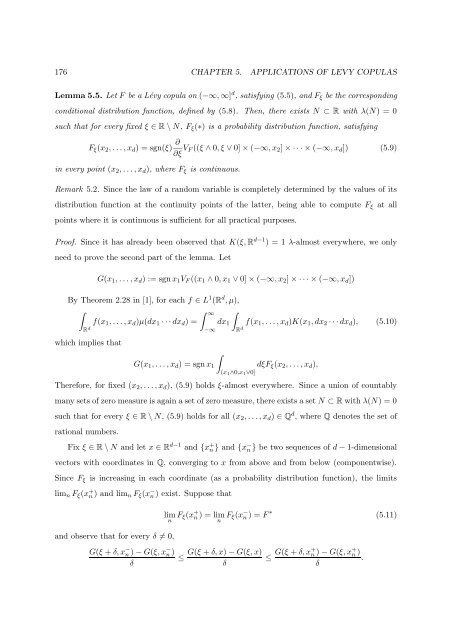Processus de Lévy en Finance - Laboratoire de Probabilités et ...
Processus de Lévy en Finance - Laboratoire de Probabilités et ...
Processus de Lévy en Finance - Laboratoire de Probabilités et ...
Create successful ePaper yourself
Turn your PDF publications into a flip-book with our unique Google optimized e-Paper software.
176 CHAPTER 5. APPLICATIONS OF LEVY COPULAS<br />
Lemma 5.5. L<strong>et</strong> F be a Lévy copula on (−∞, ∞] d , satisfying (5.5), and F ξ be the corresponding<br />
conditional distribution function, <strong>de</strong>fined by (5.8). Th<strong>en</strong>, there exists N ⊂ R with λ(N) = 0<br />
such that for every fixed ξ ∈ R \ N, F ξ (∗) is a probability distribution function, satisfying<br />
F ξ (x 2 , . . . , x d ) = sgn(ξ) ∂ ∂ξ V F ((ξ ∧ 0, ξ ∨ 0] × (−∞, x 2 ] × · · · × (−∞, x d ]) (5.9)<br />
in every point (x 2 , . . . , x d ), where F ξ is continuous.<br />
Remark 5.2. Since the law of a random variable is compl<strong>et</strong>ely <strong>de</strong>termined by the values of its<br />
distribution function at the continuity points of the latter, being able to compute F ξ at all<br />
points where it is continuous is suffici<strong>en</strong>t for all practical purposes.<br />
Proof. Since it has already be<strong>en</strong> observed that K(ξ, R d−1 ) = 1 λ-almost everywhere, we only<br />
need to prove the second part of the lemma. L<strong>et</strong><br />
G(x 1 , . . . , x d ) := sgn x 1 V F ((x 1 ∧ 0, x 1 ∨ 0] × (−∞, x 2 ] × · · · × (−∞, x d ])<br />
By Theorem 2.28 in [1], for each f ∈ L 1 (R d , µ),<br />
∫<br />
∫ ∞<br />
f(x 1 , . . . , x d )µ(dx 1 · · · dx d ) = dx 1 f(x 1 , . . . , x d )K(x 1 , dx 2 · · · dx d ), (5.10)<br />
R d −∞<br />
∫R d<br />
which implies that<br />
∫<br />
G(x 1 , . . . , x d ) = sgn x 1<br />
(x 1 ∧0,x 1 ∨0]<br />
dξF ξ (x 2 , . . . , x d ),<br />
Therefore, for fixed (x 2 , . . . , x d ), (5.9) holds ξ-almost everywhere. Since a union of countably<br />
many s<strong>et</strong>s of zero measure is again a s<strong>et</strong> of zero measure, there exists a s<strong>et</strong> N ⊂ R with λ(N) = 0<br />
such that for every ξ ∈ R \ N, (5.9) holds for all (x 2 , . . . , x d ) ∈ Q d , where Q <strong>de</strong>notes the s<strong>et</strong> of<br />
rational numbers.<br />
Fix ξ ∈ R \ N and l<strong>et</strong> x ∈ R d−1 and {x + n } and {x − n } be two sequ<strong>en</strong>ces of d − 1-dim<strong>en</strong>sional<br />
vectors with coordinates in Q, converging to x from above and from below (compon<strong>en</strong>twise).<br />
Since F ξ is increasing in each coordinate (as a probability distribution function), the limits<br />
lim n F ξ (x + n ) and lim n F ξ (x − n ) exist. Suppose that<br />
lim F ξ (x +<br />
n<br />
n ) = lim F ξ (x −<br />
n<br />
n ) = F ∗ (5.11)<br />
and observe that for every δ ≠ 0,<br />
G(ξ + δ, x − n ) − G(ξ, x − n )<br />
δ<br />
≤<br />
G(ξ + δ, x) − G(ξ, x)<br />
δ<br />
≤ G(ξ + δ, x+ n ) − G(ξ, x + n )<br />
.<br />
δ
















